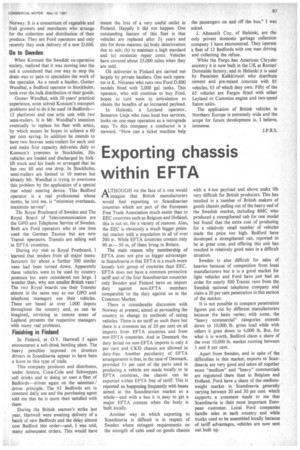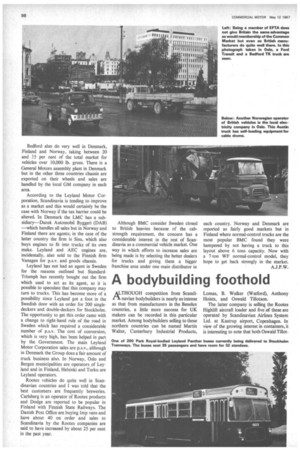Exporting chassis within EFTA
Page 99

Page 100

If you've noticed an error in this article please click here to report it so we can fix it.
ALTHOUGH on the face of it one would ra imagine that British manufacturers would find exporting to Scandinavian countries which are part of the European Free Trade Association much easier than to EEC countries such as Belgium and Holland, this is not so, for a variety of reasons. Also, the EEC is obviously a much bigger potential market with a population in all of over 200 m. While EFTA countries contain only 90 m.-50 m. of them living in Britain.
The main reason why membership of EFTA does not give us bigger advantages in Scandinavia is that EFTA is a much more loosely knit group of countries than EEC. EFTA does not have a common protective tariff and of the four Scandinavian countries only Sweden and Finland have an import duty against non-EFTA members comparable to the duty against us in the Common Market.
There is considerable discussion with Norway at present, aimed at persuading the country to change its methods of taxing vehicles. There is no tariff as such there but there is a common tax of 20 per cent on all imports from EFTA countries and from non-EFTA countries. And in Denmark the duty levied on non-EFTA imports is only 4 per cent and CKD chassis are allowed in duty-free. Another peculiarity of EFTA arrangements is that, in the case of Denmark, provided 51 per cent of the parts used in producing a vehicle are made locally or in EFTA countries, the chassis can be exported within EFTA free of tariff. This is reported as happening frequently with buses aimed at the Scandinavian market as a whole—and with a bus it is easy to get a major EFTA content when the body is built locally.
Another way in which exporting to Scandinavia is difficult is in respect of Sweden where stringent requirements on the strength of cabs used on goods chassis with a 4-ton payload and above make life very difficult for British producers. This has resulted in a number of British makers of goods chassis pulling out of the heavy end of the Swedish market, including BMC who produced a strengthened cab for one model but found that the extra cost of producing for a relatively small number of vehicles made the price too high. Bedford have developed a strengthened cab, reported to be at great cost, and offering this unit has resulted in relatively good sales in a difficult situation.
Sweden is also difficult for sales of heavies because of competition from local manufacturers but it is a good market for light vehicles and Ford have just had an order for nearly 500 Transit vans from the Swedish national telephone company and claim a 30 per cent penetration in this section of the market.
It is not possible to compare penetration figures put out by different manufacturers because the basis varies; with some, the "heavy commercial" categories extends down to 10,000 lb. gross load while with others it goes down to 6,000 lb. But, for what it is worth, Bedford claim a share of the over 10,000 lb. market running between 5 and 8 per cent.
Apart from Sweden, and in spite of the difficulties in this market, exports to Scandinavia are very good and taken all together more "medium" and "heavy" commercials are registered there than in Belgium and Holland. Ford have a share of the mediumweight market in Scandinavia generally varying between 20 and 30 per cent which supports a comment made to me that Scandinavia is their most important European customer. Local Ford companies handle sales in each country and while trucks used to be assembled locally because of. tariff advantages, vehicles are now sent out built up. Bedford also do very well in Denmark, Finland and Norway, taking between 20 and 35 per cent of the total market for vehicles over 10,000 lb. gross. There is a General Motors assembly plant in Denmark but in the other three countries chassis are exported on their wheels and sales are handled by the local GM company in each area.
According to the Leyland Motor Corporation, Scandinavia is tending to improve as a market and this would certainly be the case with Norway if the tax barrier could be altered. In Denmark the LMC has a subsidiary—Dansk Automobil Byggeri (DAB) —which handles all sales but in Norway and Finland there are agents; in the case of the latter country the firm is Sisu, which also buys engines to fit into trucks of its own make. Leyland and AEC engines are, incidentally, also sold to the Finnish firm Vanagen for p.s.v. and goods chassis.
Leyland has not had an agent in Sweden for the reasons outlined but StandardTriumph has recently bought out the firm which used to act as its agent, so it is possible to speculate that this company may turn to trucks. This has become more of a possibility since Leyland got a foot in the Swedish door with an order for 200 singledeckers and double-deckers for Stockholm. The opportunity to get this order came with a change to right-hand rule of the road in Sweden which has required a considerable number of p.s.v. The cost of conversion, which is very high, has been helped in part by the Government. The main Leyland Motor Corporation sales are p.s.v., although in Denmark the Group does a fair amount of truck business also. In Norway, Oslo and Bergen municipalities are operators of Leyland and in Finland, Helsinki and Turku are Leyland operators.
Rootes vehicles do quite well in Scandinavian countries and I was told that the best customers are frequently breweries. Carlsberg is an operator of Rootes products and Dodge are reported to be popular in Finland with Finnish State Railways. The Danish Post Office are .buying Imp vans and have about 40 on order and sales to Scandinavia by the Rootes companies are said to have increased by about 25 per cent in the past year Although BMC consider Sweden closed to British heavies because of the cabstrength requirement, the concern has a considerable interest in the rest of Scandinavia as a commercial vehicle market. One way in which efforts to increase sales are being made is by selecting the better dealers for trucks and giving them a bigger franchise area under one main distributor in each country. Norway and Denmark are reported as fairly good markets but in Finland where normal-control trucks are the most popular BMC found they were hampered by not having a truck to this layout above 6 tons capacity. Now with a 7-ton WF normal-control model, they hope to get back strongly in the market.
A.J.P.W.
















































































































































































































































